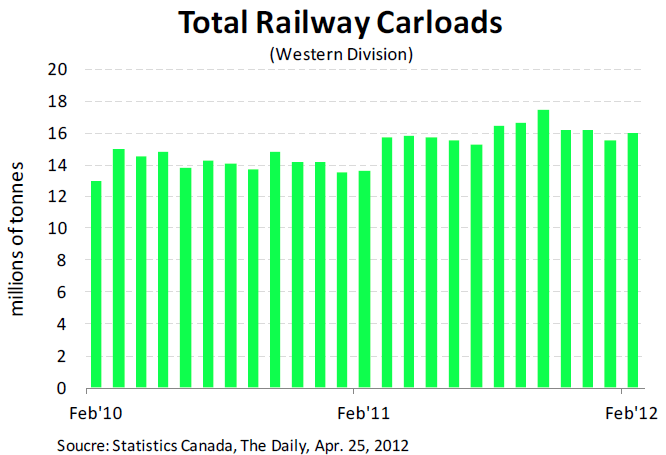Western Canada’s Economic Growth – Railcar Indicator
- May 3, 2012
- By Cody Battershill
Western Canada's Economy is Growing as Indicated by Freight Amounts
 Economists are given the duty to track several different indicators to understand how the Canadian economy is faring. One of these indicators is found in the transportation industry. Everything from metal ore’s and grains to drilling pipe and packaged flat screen TV’s from Asia is accounted for by Statistics Canada then put into a report. Therefore the rising amount of carloads in Canada’s west suggests the economy is growing. Large amounts of these railcars stop in Calgary, western Canada's main transportation hub and also Canada's Economic Epicentre!
Economists are given the duty to track several different indicators to understand how the Canadian economy is faring. One of these indicators is found in the transportation industry. Everything from metal ore’s and grains to drilling pipe and packaged flat screen TV’s from Asia is accounted for by Statistics Canada then put into a report. Therefore the rising amount of carloads in Canada’s west suggests the economy is growing. Large amounts of these railcars stop in Calgary, western Canada's main transportation hub and also Canada's Economic Epicentre!
More Freight, More Money...
- For February of 2012, 16 million tonnes of freight was moved in railcars, an astonishing 17 per cent higher than in February of 2011.
- Over the past year the total amount of freight moved has increased 12.9 per cent.
- Winter seasons bring less freight shipped for obvious reasons
Railcars in western Canada are typically loaded with bulk items such as oilseeds and grains from our Prairie Provinces. Last year at harvest time in the west, farmer fields produced high yields, so it isn’t so surprising to see higher amounts of these resources moving towards ports in cities like Vancouver to be shipped elsewhere. Most of our other natural resources freighted to port cities in railcars for international trade like petroleum products, chemicals and base metals for the most part have had a steady price tag. For more interesting facts on Canada, check out Canada By the Numbers!
One of the main contributing factors to seeing an increasing amount of freight being shipped in railcars over the past two years is due to the economic growth in emerging Asian nations, especially China. As long as there is no unexpected drop in demand from these nations, Canadians should expect to see continued increase in the amount of freight being shipped to our ports for international trade. This is a good sign for the western Canadian economy and should create some jobs in the process.



